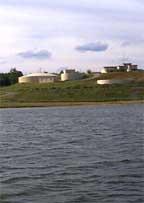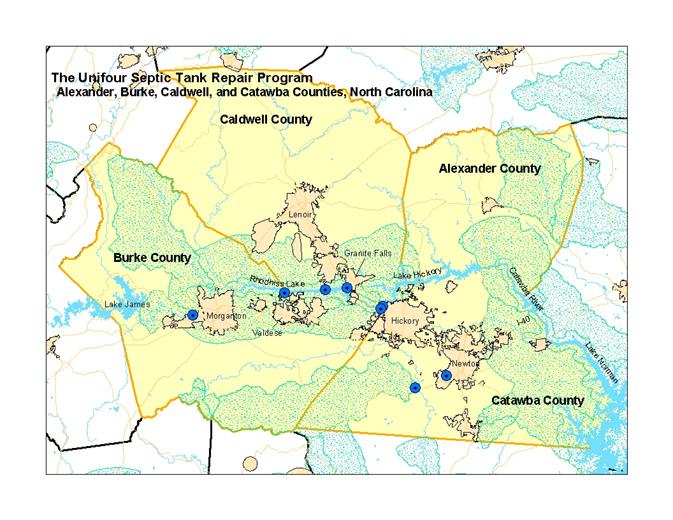Alexander, Burke, Caldwell, & Catawba Counties
The Unifour Septic Tank Repair Program

Acting Entity: Western Piedmont
Council of Governments
and Alexander, Burke, Caldwell
and Catawba Counties
Contact Person: Mike Struve
Cost: $453,500
Population Served: 106,405
Water Supply: Reservoir, Lake Hickory,
Lake Rhodhiss, Catawba River, Jacobs Fork
River, Town of Longview, City of Hickory,
City of Lenoir, Town of Valdese, Town of
Granite Falls, Town of Morganton,
Town of Newton
PWS ID: 0118025, 0118010, 0114010,
0112010, 0114030, 0112015, 0118015
Helping Organizations:
· North Carolina Land and Water Fund
· Several County Environmental Health Offices
· Bank of America
· Western North Carolina Housing Partnership
Funding Sources:
· $450,000 from North Carolina Land and Water Fund to set up revolving loan program.
· $3,500 from Western North Carolina Housing Partnership for administrative start-up costs
Features:
· This effort was led by a regional Council of Governments.
· The "Unifour" counties came together to implement a plan to protect and improve water quality in area streams and lakes. This seems like an obvious approach since water supplies ignore jurisdictional boundaries, yet many cities have not heeded the regional nature of water.
· Citizens from four counties can benefit from this program.
· The revolving nature of this program will allow residents to benefit for an infinite
amount of time.
· The impetus for this program was the knowledge that the region has a high concentration of septic tanks relative to other areas of the state as reported in an article appearing in the Raleigh News and Observer.
Summary: The town of Asheville has owned the land comprising its watershed since the early 1900s. In 1995, CTNC contacted the waterplant superintendent, Charlie Casey, about further protecting Asheville's watershed by placing a conservation easement on the property. The easement would be designed to exclude certain activities on the land, such as commercial development or residential subdivisions, with its primary purposes being to conserve the natural landscape and protect the water resources. Casey liked the idea and presented it to his manager, Mike Holcombe, the Director of Water Resources. At that time, the possibility of timber cutting in the watershed was being discussed. Holcombe recognized that in addition to protecting the water supply, a conservation easement would allow selective forest management on the watershed while preserving the aesthetic value of the land and protecting water quality. The watershed area can be viewed from the Blue Ridge Parkway, a nationally renowned tourist attraction boasting great natural beauty.
The next step involved bringing the concept to Jim Westbrook, the City Manager. He too liked the idea and brought it before the City Council. The conservation easement met no opposition in Asheville and the Asheville City Council signed the idea into law. The City of Asheville has now fully protected its 18,000-acre watershed. The easement is monitored at least once a year by CTNC, by flying over the area by plane and driving or hiking much of the property. This ensures that the provisions of the easement are being maintained and the water quality is being protected.


